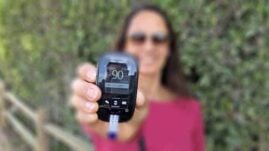1 in 3 American adults have prediabetes—and nearly 80% of people with prediabetes don’t even know they have it!
Prediabetes is incredibly common. However, it’s important for you to know the causes so you can delay or prevent it, especially if you are at a higher risk of developing it.
This article will explain what prediabetes is, as well as the symptoms, causes, and prevention tips.

What is prediabetes?
Prediabetes is diagnosed when blood sugar levels (both fasting and after meals) are more elevated than normal—but not elevated enough to constitute a diabetes diagnosis.
Without intervention, people diagnosed with prediabetes are at a much higher risk of developing type 2 diabetes.
Blood sugar levels to diagnose prediabetes are the following:
- Fasting blood sugar between 100-125 mg/dL
- Blood sugar 2 hours after a meal between 140-199 mg/dL
- An HbA1c test between 5.7-6.4%
The good news is that with changes to diet and increased physical activity, prediabetes is highly manageable and even preventable with appropriate and timely interventions.
What are the symptoms of prediabetes?
Prediabetes often has no symptoms, which can make the condition difficult to diagnose and treat.
People live with prediabetes for years without a diagnosis.
This can lead to health complications later in life, including changes in vision, heart disease, stroke, kidney failure, and even premature death.
It’s good to know the early signs. Talk to your doctor if you’re experiencing any of the following symptoms:
- Thirst
- Fatigue
- Frequent urination/polyuria
- Extreme hunger
- Dry mouth
- Fruity-smelling breath
- Blurry vision/changes to vision
- Lethargy
- Body Aches
- Slow-healing wounds
Contact your doctor immediately if you have been experiencing any of these symptoms for two or more weeks without explanation. Ask for a blood glucose test to rule out prediabetes.
Learn more: How Often Should You Test For Prediabetes?
Who is at higher risk for prediabetes?
Some groups of people are at a higher risk for developing prediabetes.
While some risk categories are in your control, others, like your family history, are outside of your control. The more groups you fall into, the higher your risk is for prediabetes.
Factors that you cannot control:
- You have a direct relative who has type 2 diabetes
- You are 45 years or older
- You are African-American, Hispanic, Native-American, Pacific Islander, or Asian-American
- You have Polycystic Ovary Syndrome (PCOS)
- You have Cushing’s Syndrome or Acromegaly
- You have sleep apnea
- You had gestational diabetes while pregnant
- You take steroids for a health condition, are on antipsychotic or HIV medications
The following risk factors you can control and modify to lower your risk of prediabetes:
- You are overweight or obese
- You eat a poor diet, full of saturated fats and added sugars
- You live a sedentary lifestyle and get no regular exercise
- You have uncontrolled high blood pressure and/or high cholesterol
- You have metabolic syndrome, which is a combination of hypertension, high cholesterol levels, and a large waist measurement
- You smoke cigarettes
- You drink alcohol
Make small lifestyle changes to drastically lower your risk of developing prediabetes.
What causes prediabetes?
While no single risk factor causes prediabetes, having one or more risk factors increases your chances of developing prediabetes. The exact cause of prediabetes is still unknown, but family history and genetics play a big role.
“My journey started back in 2017 when my doctor told me I had an A1c of 5.9 percent and that I was prediabetic.
It wasn’t something that I was unfamiliar with. Most of my family members on my mother’s side already had type 2 diabetes and were either on oral medication or insulin-dependent.”
Venus Jones (read Venus’ story of reversing prediabetes)
However, research shows that the primary risk factor for prediabetes is being overweight or obese. This does not mean that if you’re overweight or obese you will automatically develop prediabetes.
Not everyone with prediabetes is overweight or obese. But if you are overweight or obese, your risk for prediabetes does increase.
This is because the more fatty tissue you have, especially around the organs in your abdomen, the more insulin-resistant you become. Over time, insulin resistance turns into prediabetes.
Losing fatty tissue increases your insulin sensitivity and lowers your risk for prediabetes. Even just losing between 5-7% of your body weight can make a significant difference in your risk for prediabetes.
Talk with your doctor if you’re concerned about your weight or if you fall into several risk factor categories for prediabetes. They can help you formulate a plan to take charge of your health and lower your risk for the condition.
How can you prevent prediabetes?
It is impossible to prevent all cases of prediabetes. However, there are many ways to lower your risk of developing prediabetes and type 2 diabetes.
Some strategies may include:
- Lose excess weight or maintain a healthy weight
- Aim for at least 150 minutes of moderate activity per week( about 30 minutes or more per day) and two days of strength training per week
- Work with a registered dietician (RD) to create a healthy meal plan
- Limit all processed foods and foods with added sugar
- Manage stress levels
- Get 7-9 hours of sleep per night
- Take all your prescription medications as prescribed
- Quit smoking
- Limit your alcohol consumption
How do you manage prediabetes?
Prediabetes is primarily managed with proper diet and exercise. Healthy weight loss has been shown to improve insulin sensitivity and delay or prevent the onset of type 2 diabetes.
Medications such as metformin may be prescribed, but studies have shown that diet and exercise are just as, if not more, effective.
Occasionally, people are prescribed insulin to manage their prediabetes.
Learn more: Prediabetes Medication: What are the Options?
Is prediabetes reversible?
Yes! The good thing about prediabetes is that it is reversible with timely intervention.
A healthy diet and exercise routine is recommended to help prevent the onset of type 2 diabetes. A common goal is to lose 5-7% of total body weight.
Talk with your doctor about the lifestyle changes you need to help you reverse your prediabetes.
Better yet, ask for a referral to the National Diabetes Prevention Program, which has been proven to reverse prediabetes and prevent the onset of type 2 diabetes by up to 58% (and 71% in people over 60 years old.)
Learn more: What is the Most Effective Way to Reverse Prediabetes?
What foods should you avoid if you have prediabetes?
If you have prediabetes, you will want to eat foods that promote insulin sensitivity—not insulin resistance.
Foods that exacerbate insulin resistance include:
- Greasy, fatty, and fried foods
- Processed foods
- Foods and beverages with added sugar
- Sugary condiments
Instead, stick to a diet full of whole, unprocessed foods, fiber, and water.
Try these healthy—and delicious—options instead:
- Vegetables: Kale, Brussels sprouts, and cauliflower
- Low-glycemic fruit: Blueberries and strawberries
- Lean proteins: Chicken, tofu, turkey, and fish
- Low-fat dairy: Greek yogurt and milk
- Healthy fats: Avocado, extra virgin olive oil, and nuts
Learn more: Prediabetes Diet: What to Eat & What to Avoid



